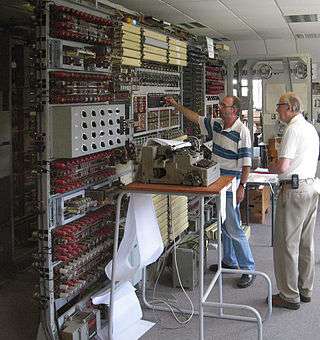The National Museum of Computing
 The Entrance | |
| Established | 2007 |
|---|---|
| Location | Bletchley Park, UK |
| Coordinates | 51°59′55″N 0°44′37″W / 51.9985°N 0.7435°W |
| Website | www.tnmoc.org |
The National Museum of Computing is a museum in the United Kingdom dedicated to collecting and restoring historic computer systems.[1] The museum is based at Bletchley Park in Milton Keynes, Buckinghamshire and opened in 2007. The building — Block H — was the first purpose-built computer centre in the world, hosting six Colossus computers by the end of World War II.
The museum houses a rebuilt Colossus computer alongside an exhibition of the most complex code cracking activities performed at the Park, along with examples of machines continuing the history of the development of computing from the 1940s to the present day. The museum has a policy of having as many of the exhibits as possible in full working order.
Although located on the Bletchley Park 'campus', The National Museum of Computing is an entirely separate charity with its own fund raising and separate entrance/ticketing. TNMOC receives no public funding and relies on the generosity of donors and supporters.
Exhibits
On display in the museum are many famous early computing era machines, including a rebuild of Colossus Mark 2, a machine that helped break German encryption during World War II.[2] The Colossus rebuild project and related machines are open to visitors seven days a week.

The museum also includes the world's oldest working digital computer (the Harwell Dekatron / WITCH), machines from the 1960s such as the Marconi Transistorised Automatic Computer (T.A.C.), Elliott 803 and 905, an ICL 2966 mainframe from the 1980s, a wide range of analogue computers, a hands-on retrocomputing gallery, and several restoration projects such as the PDP-8 and the PDP-11-based air traffic control system from London Terminal Control Centre at West Drayton near London. Further exhibits include mechanical and electronic calculators, a history of slide rules, a pair of Cray super computers, and a personal computing gallery with ten hands-on machines. Visitors can also see a re-creation of the Cambridge University EDSAC computer that is being built and which is expected to be commissioned as a working replica at the end of 2015.
Another area includes a range of electro-mechanical punched card machines. At the end of 2009, an Internet gallery, sponsored by the National Physical Laboratory where packet switching was first developed, was opened, along with a shop and an education room.
Opening
The Colossus and Tunny Galleries are open daily.
The rest of the Museum is open to the public every Thursday, Saturday and Sunday afternoons and most bank holidays, and by appointment for groups only at other times. There are guided tours on Tuesday afternoons, Thursday mornings and other times. There is a modest admission charge to the museum to help cover overheads (including rent).
Funding
TNMOC depends for funding entirely on voluntary and corporate donations and modest admission charges. Fundraising continues and donors have included Bletchley Park Capital Partners, Fujitsu, Google UK, CreateOnline, Ceravision, Insight software, PGP Corporation, IBM, NPL, HP Labs, BCS, Black Marble, and the School of Computer Science at the University of Hertfordshire.
The museum is managed by the Codes and Ciphers Heritage Trust, a registered charity,[3] with employed and volunteer staff. The title The National Museum of Computing is an operating name.
References
External links
| Wikimedia Commons has media related to The National Museum of Computing. |